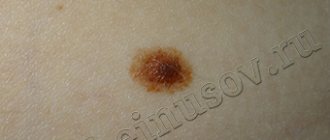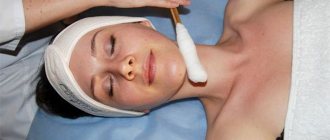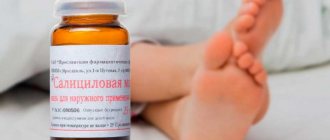Papilloma is a common defect caused by excessive growth of the epithelium. In most cases, the formations resemble pointed papillae, a rooster's comb, or cabbage inflorescences. One of the ways to restore beauty to the skin is electrocoagulation of papillomas - cauterization of the affected tissues with electric current discharges of a certain frequency and force of influence.
Introduction
Clean, smooth skin without cosmetic defects has always been an indicator of quality care and is highly valued.
But in cases of serious skin pathologies, the main thing is not to leave things to chance, but to seek help from the appropriate specialists as quickly as possible. A number of cases require serious treatment; in other situations, such as when papilloma occurs, simple procedures are sufficient.
The principle of operation of the electrocoagulator
The electrocoagulation method is based on the use of direct or high-frequency electric current. When the electrode comes into contact with tissue, energy is released, which causes the evaporation of intercellular fluid and the coagulation of proteins. If the current frequency is low, a blister will form during evaporation.
Point exposure using an electrode allows you to limit the area of excision (cauterization) without damaging healthy tissue. Electrocoagulation is performed under local anesthesia.
Advantages and disadvantages of electrocoagulation
The advantages of this method are:
- Versatility . Electrocoagulation is used not only in cosmetology. Stopping bleeding in surgery, cauterizing hemorrhoids in proctology, destroying polyps in ENT practice, treating erosions in gynecology - this is not a complete list of areas of medicine that practice this method. And in cosmetology it is almost limitless - eliminating nevi and capillary mesh, removing tattoos and warts, fighting hemangiomas and papules, treating Darier's disease, rosacea, and much more.
- Possibility to examine the obtained samples for the presence of cancer cells . The admissibility of histological analysis distinguishes the method favorably from cryodestruction or laser therapy, since the papilloma in this case is not completely destroyed and provides a sufficient amount of material.
- Reliability of the procedure . The soldering of blood vessels during cauterization eliminates extensive blood loss, and the layer of dehydrated tissue at the site of removal shrinks into a crust, which prevents infection from entering the wound.
- Speed . Most often, only one procedure is necessary to eliminate the formation.
- Painless . Whether pain relief is needed or not is decided by the patient after consultation with the doctor. Removing single small papillomas takes 1–2 seconds; the use of anesthesia in this case is not advisable. Extensive skin lesions require injections such as ice-caine. For small patients with significant damage, light inhalation anesthesia is used. Action time: 5–7 minutes. Subsequently, the child does not retain any negative memories.
- Fast recovery . Careful adherence by patients to postoperative care recommendations guarantees restoration of the skin in 10–12 days. The risk of scarring is minimized.
- Lack of preparatory procedures.
- Maximum accuracy.
- The doctor independently regulates the level and mode of thermal influence only on the neoplasm tissue, excluding the effect on healthy areas.
Disadvantages include:
- Soreness . Since everyone’s pain threshold is different, cauterization of a papilloma may cause a dissatisfied grimace in one person, and deep fainting in another. Removing papilloma from the feet and soles is especially unpleasant.
- The use of local anesthetics for pain relief carries the risk of an allergic reaction.
- The burn site must be treated throughout the recovery period..
- Unfortunately, it is impossible to give a 100% guarantee that there will be no scars . If the removal was quite deep, the neoplasm is extensive, and the scab is accidentally damaged, a scar may appear. In addition, cauterization can cause tissue depigmentation, which will stand out noticeably against the background of healthy skin.
- In rare cases, tissue necrosis and relapse are possible.
Answers to frequently asked questions
When identifying such benign neoplasms that cause psychological discomfort and worsen the appearance of the skin, questions most often arise related to the duration of the operation, the degree of its pain and the period of further recovery.
- How long does it take for a wound to heal after electrocoagulation? After electrocoagulation, it takes about 12-14 days, after which the scab that has formed completely dries out and falls off on its own. After such healing, there are no traces or scars left on the skin that spoil the appearance of the skin.
- Can this be done for children? Electrocoagulation is also permissible in childhood, since the duration of exposure to electric current is minimal, the area of skin damage is also small, and the healing rate is maximum with proper care of the treated area. Monitoring by a dermatologist when using this method for children will minimize health risks and allow damaged areas of the skin to be restored more quickly.
- What to do with crusts and scars after EC? After completing the procedure, you should not tear off the scab that has formed, which will turn into a dry crust as it dries. Removing it yourself will avoid the formation of scars and marks on the skin. The treatment area should be disinfected with special solutions, slightly pink potassium permanganate.
Electrocoagulation of moles and papillomas is described in detail in this video:
Contraindications for using an electric knife
Despite its many advantages, electrocoagulation also has a number of contraindications. The patient should consult with his doctor about all the nuances before signing up for the procedure. A specialist may advise you to undergo additional examination and tests to exclude future complications.
The procedure is strictly contraindicated if:
- violation of blood clotting processes;
- individual intolerance to procedures using electric current;
- herpetic skin rashes (or warning signs);
- exacerbation of a chronic disease;
- allergies to the anesthetic used;
- oncological diseases;
- endocrine diseases (for example, diabetes);
- diseases of the cardiovascular system (pulmonary and heart failure, arterial hypertension);
- immune deficiency syndrome;
- suspected malignant degeneration of the formation;
- with a pacemaker installed;
- for nervous pathologies, epilepsy and other mental disorders;
- photodermatosis (increased sensitivity to both direct and diffuse sunlight).
Important!
The above features exclude the use of the described method, but do not prohibit alternative methods. The use of laser, cryodestruction, and surgical removal are also popular and have their advantages.
Acute respiratory viral diseases, pregnancy and breastfeeding are reasons to postpone the procedure.
More information about our clinic
Diagnosis and treatment of papillomatosis in a medical clinic is carried out anonymously at the request of the patient. We offer prompt removal of papillomas using electrocoagulation in comfortable conditions, with a guarantee:
- personal approach;
- flawless results;
- maintaining sterility and safety.
You can have papillomas and warts removed in our clinic at an affordable price. To make an appointment with a dermatologist, call the phone number listed on the website.
How is it done?
- The patient is placed on the couch, the surface of the skin is treated with a disinfectant.
- If necessary, an anesthetic injection is given.
- The formation is cauterized using an electrode. Under the influence of high temperature (up to 80 degrees), the leg of the papilloma is excised, and high-frequency currents act on the base. Small vessels are sealed, which eliminates bleeding. If the papilloma “sits” deep, it is burned out from there.
- Next, apply corticosteroid ointment and apply a sterile bandage or patch.
- The remaining tissue is sent for histological examination.
The safety and effectiveness of cauterization depends on the skill and experience of the physician. The number of papillomas and the degree of their localization affects the settings of the device and the choice of a suitable attachment: an electrode with a ball at the end, a metal loop or a needle.
REFERENCE! It is best to remove papillomas in autumn or winter. It is recommended to cover the treated area from ultraviolet radiation for 1–2 months to avoid the appearance of pigmentation. In addition, excessive sweat helps soften the scab, and the healing process is delayed, increasing the risk of scarring.
Important!
Before the procedure, you should not drink alcohol - the quality of anesthesia may decrease.
Skin neoplasms
Under the influence of various factors, ranging from infections and tight clothing to genetics, convex formations may appear on the smooth surface of the skin, for example, moles, warts, papillomas, condylomas, fibroids, calluses.
Most often, they are small, painless and do not interfere with a person’s normal life and going about their business. But in some cases, these small troubles can turn into a big problem.
- Large skin defects on the face, hands, and genitals cause aesthetic discomfort.
- Growths in the armpits, hands and feet, crooks of the limbs, groin and other areas with high levels of sweating interfere with movement, can cause discomfort and can be damaged and infected during physical activity or sports.
- Skin tumors that have a thin interception - papillomas - are especially dangerous. Small vessels and nerves often pass through this narrow leg, so twisting or pinching it is painful and can lead to necrotic processes.
- Small moles that suddenly begin to grow and visually change indicate malignant processes in the body.
Skin defects that cause discomfort cannot be removed on your own. Incorrectly performed manipulations lead to the introduction of infection into the blood, and in some cases provoke the degeneration of a benign neoplasm.
How long does it last and how much does it cost?
The procedure takes little time: from 2 to 15 minutes (depending on the number of tumors). The growths on the “leg” are removed the fastest; the wide base is burned out gradually in layers, which takes longer.
The price tag ranges from 400 to 1500 rubles per procedure. The cost is influenced by the depth of the “roots” of the papilloma and the total area of the lesion, as well as the qualifications of clinical workers. Anesthesia and histological examination are paid separately. In addition, in some medical centers, treatment of the skin of the face and eye area is more expensive than the body.
Indications for testing
This type of effect on the skin and removal of tumors can be prescribed for the following diseases and pathological conditions of the skin:
- skin papillomas and condylomas;
- warts of various types;
- age spots and skin hyperpigmentation;
- postoperative scars that do not heal for a long time and keloid;
- keratomas;
- rosacea, accompanied by the formation of a network of small blood vessels on the skin;
- hemangiomas;
- papules;
- Darier's disease;
- rosacea;
- nevus of any location;
- erosion of cervical tissue;
- porokeratosis, seborrheic keratosis;
- cystic acne;
- polyps in the genital area.
The listed pathological conditions of the skin in the area of the face, neck, and genitals can be supplemented by the symptoms of spider veins in the upper layer of the epidermis, wen, molluscum contagiosum, and xanthelasma. All of them can be cured by excision of the tissue forming the tumor.
Electrocoagulation device
Wound care
The healing time is about two weeks, and during this period the patient must take careful care of the wound. Above all else at this time - accuracy and sterility.
The dressing is changed to a fresh one 2-3 times a day. Before applying a clean bandage, the wound is treated with a recommended antiseptic (Miramistin, Chlorhexidine) or a weak solution of potassium permanganate. Alcohol solutions are not used due to drying of the skin.
The crust that forms on the wound should not be picked off, wetted or combed with your fingers. Visits to saunas, baths and swimming pools are temporarily cancelled. The place is protected from sunlight. Decorative cosmetics, treasures, alkalis and pumice are also not used.
After the crusts fall off, the healing site can be lubricated with vitamins E, A and olive oil.
Recovery after the procedure
Skin treated with electric discharge should be carefully wiped with an antiseptic for a week. A small crust remains in place of the burnt growths, which disappears on its own within two weeks. The area of skin around the crust is a little itchy in the first couple of days - the body reacts to interference with its integrity, and this is normal.
Prevention
It is easier to prevent a disease than to treat it - it is long, tedious and expensive. Certain preventive measures - the basics of a healthy lifestyle - will help prevent the development of such an unpleasant skin disease as papillomas:
- Compliance with hygiene standards.
- A healthy balanced diet, taking vitamins and minerals (especially ascorbic acid).
- Reasonable physical activity and hardening.
- Full sleep.
- Quitting smoking and alcohol.
- Regular medical examinations.
- Maintaining immunity at a high level.
- Cleansing the body of waste and toxins.
Reviews about the removal of papilloma using electrocoagulation
In most cases, the electrocoagulation procedure is rated very highly.
What do patients like? First of all, speed. There is no need to prepare in advance, go on a diet or take medications either before or after the procedure. Once completed, they can go home and do normal household chores, sports and studies.
Svetlana, 33 years old, housewife. “There was a papilloma on my foot for many years, which in the last year began to increase in size and wear off until it bled. I suffered while walking and had problems choosing shoes. I decided to go to the clinic and did not regret it: the papilloma was removed on the same day. Everything went quickly, without pain. I immediately started walking normally.”
The list of postoperative complications is very small, as is the price, which distinguishes this process from similar methods.
The pain is mild and does not last long. Aftercare is simple and easy to carry out in any conditions. The percentage of appearance defects is so tiny that rarely does anyone go through the procedure with fear or anxiety.
Anya, 21 years old, fashion model. “Modern technology is simply magic! A year ago, a papilloma appeared on my nose. I can’t express my feelings in words – my appearance is ruined! And it’s scary to remove it - what if a scar remains! I learned about the electrocoagulation method. Signed up for removal.
Everything went quickly, there was practically no pain, only a slight smell of burnt skin. I paid 2000 rubles. They gave me a care manual. After two weeks, the wound healed completely: no scar, no sore - the skin is smooth, slightly, although the color is different. The doctor explained that this is a temporary phenomenon and gradually the color will become normal. I am very pleased!
Features of treatment
Warts are caused by the Human Papilloma Virus. It cannot be infected in transport, on the street or through food - it is present in the body from birth in almost every person on the planet. Its exacerbation occurs when certain factors confluence, so in some people Papilloma causes thickening of skin growths in the form of condylomas, warts and papillomas, in others are in “sleep mode” and do not cause any trouble to a person.
Using the method of external influence, only the manifestation of the virus is removed, not the source itself. Under favorable circumstances, growths do not form again; only in isolated cases does a relapse occur.
Coagulation of warts and similar methods of removing growths are serious methods of treatment from the category of microsurgical intervention. Therefore, to get rid of small growths, dermatologists first recommend using home therapy methods - burning with celandine, using pharmaceutical ointments for warts, using alcoholic herbal tinctures that provoke the death of pathological cells. And only if they are ineffective, contact a cosmetology office for surgery.











